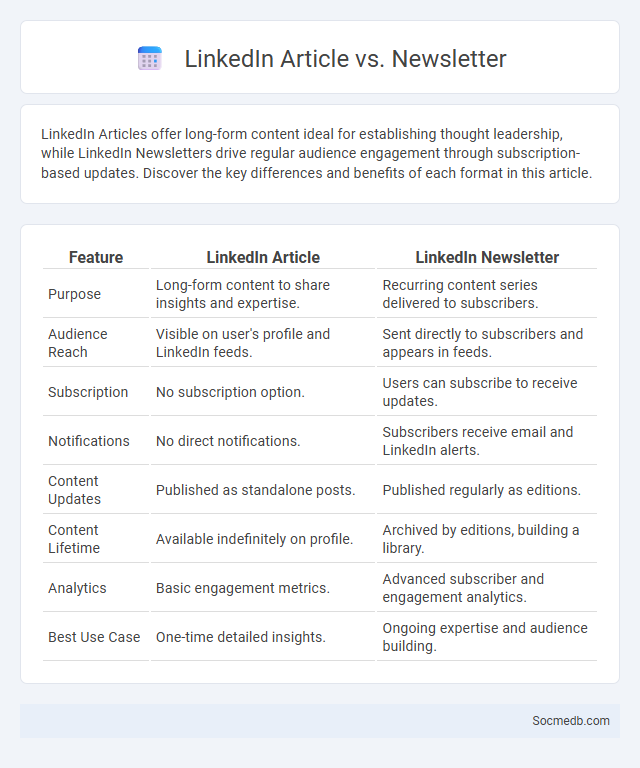
Photo illustration: LinkedIn Article vs Newsletter
LinkedIn Articles offer long-form content ideal for establishing thought leadership, while LinkedIn Newsletters drive regular audience engagement through subscription-based updates. Discover the key differences and benefits of each format in this article.
Table of Comparison
| Feature | LinkedIn Article | LinkedIn Newsletter |
|---|---|---|
| Purpose | Long-form content to share insights and expertise. | Recurring content series delivered to subscribers. |
| Audience Reach | Visible on user's profile and LinkedIn feeds. | Sent directly to subscribers and appears in feeds. |
| Subscription | No subscription option. | Users can subscribe to receive updates. |
| Notifications | No direct notifications. | Subscribers receive email and LinkedIn alerts. |
| Content Updates | Published as standalone posts. | Published regularly as editions. |
| Content Lifetime | Available indefinitely on profile. | Archived by editions, building a library. |
| Analytics | Basic engagement metrics. | Advanced subscriber and engagement analytics. |
| Best Use Case | One-time detailed insights. | Ongoing expertise and audience building. |
Understanding LinkedIn Articles: Definition & Purpose
LinkedIn Articles are long-form content pieces published on the LinkedIn platform, designed to share insights, professional expertise, and industry trends. They serve as a tool for thought leadership, allowing users to establish credibility and engage their professional network with detailed information beyond typical posts. Leveraging LinkedIn Articles effectively enhances personal branding, drives meaningful interactions, and supports career development within the platform's professional community.
What Are LinkedIn Newsletters? Key Features Explained
LinkedIn Newsletters are a content publishing feature that allows professionals to create and distribute recurring articles to their network and followers directly on LinkedIn. Key features include subscription-based delivery, enabling readers to receive notifications of new editions, and enhanced engagement tools such as likes, comments, and shares to foster community interaction. This format supports thought leadership by facilitating regular, targeted communication to a highly relevant professional audience.
Traditional Articles: Scope and Audience Reach
Traditional articles on social media platforms often target a broad, diverse audience seeking in-depth analysis, news, and expert opinions. Your content can leverage detailed storytelling and authoritative voice to engage readers who prefer comprehensive information over quick updates. These articles have the potential to increase brand credibility and reach demographics interested in thorough, well-researched material.
Content Creation Process: Articles vs Newsletters
Content creation for social media involves distinct strategies when comparing articles and newsletters. Articles typically require in-depth research, SEO optimization, and engaging headlines to attract organic traffic on platforms like blogs and LinkedIn. Newsletters demand concise, personalized content with a clear call-to-action to maintain subscriber retention and drive direct engagement via email marketing tools such as Mailchimp or Constant Contact.
Engagement Metrics: Comparing LinkedIn Articles and Newsletters
Engagement metrics for LinkedIn Articles and Newsletters differ significantly, with Articles typically generating higher views and comments, while Newsletters excel in consistent subscriber interactions and open rates. Your choice between these formats should consider the depth of content and how you want to foster community engagement, as Articles encourage public discussion and Newsletters build loyal readership over time. Tracking metrics like click-through rates, shares, and time spent on content provides a comprehensive view of your audience's preferences and engagement quality.
Distribution and Visibility on LinkedIn
LinkedIn's distribution algorithm prioritizes professional relevance, promoting content that aligns with users' industries, job roles, and network interactions to maximize visibility. Posts with high engagement such as likes, comments, and shares are more likely to be featured in users' feeds, increasing organic reach among targeted professional connections. Utilizing LinkedIn's native features like hashtags, LinkedIn Groups, and employee advocacy further enhances content distribution and amplifies brand visibility within specific professional communities.
Audience Building: Subscriber Models vs Followers
Subscriber models foster deeper audience engagement by requiring users to opt-in, often via paid subscriptions, which leads to higher content loyalty and consistent revenue streams. Follower-based models prioritize reach and visibility, allowing easy access and broad audience growth but often result in lower engagement rates and less predictable income. Brands should weigh the value of quality interactions through subscribers against the scalability of follower counts to optimize their social media strategies.
Search Engine Optimization: Which Performs Better?
Search engine optimization (SEO) typically delivers better long-term organic traffic and higher conversion rates compared to social media due to its targeted keyword strategies and website ranking improvements. While social media enhances brand awareness and engagement through shareable content and real-time interaction, SEO optimizes your website's visibility on search engines, leading to sustained user acquisition. Investing in SEO ensures your content reaches users actively searching for relevant information, improving your online presence and business growth.
Best Use Cases: When to Choose Each Format
Social media formats excel when aligned with specific goals: video content drives high engagement and brand awareness on platforms like TikTok and Instagram Reels, while images and carousels are ideal for showcasing product features and generating interest on Facebook and Pinterest. Text-based posts and polls work best for fostering community interaction and gathering feedback on LinkedIn and Twitter. Stories and ephemeral content boost urgency and exclusive offers, maximizing conversions through time-sensitive promotions on Snapchat and Instagram Stories.
Making the Right Choice for Your Content Strategy
Selecting the optimal social media platform for your content strategy hinges on understanding your target audience's demographics and behavior patterns. Analyzing engagement metrics like click-through rates and follower growth on platforms such as Instagram, TikTok, LinkedIn, and Twitter can guide tailored content creation that maximizes reach and interaction. Prioritizing platforms aligned with your brand's goals and investing in consistent, quality posts enhances organic visibility and drives sustainable growth.
 socmedb.com
socmedb.com